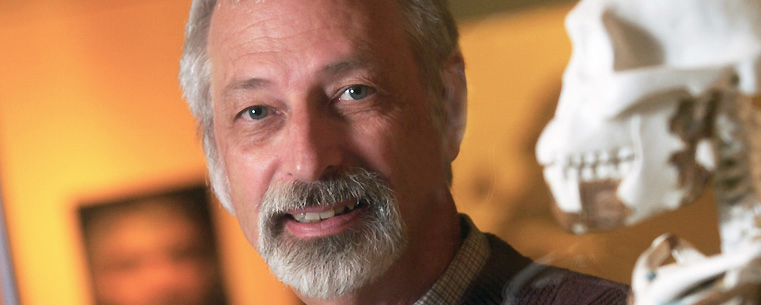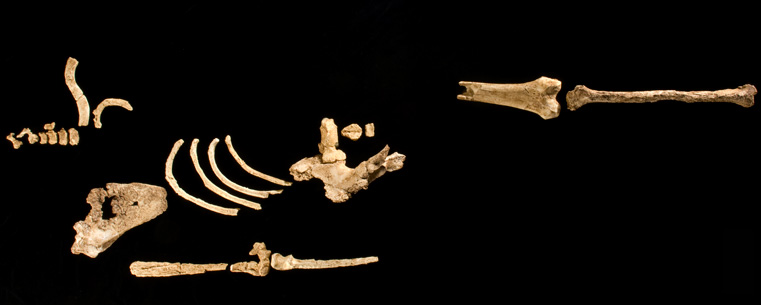Recent Success Stories
- New Kent State President Embarks on Listening Tour
- Scholar Helps Fight Crime With Violence Prevention Research
- Welcome, President Warren
- Destination
Kent
State
Returns - Now Serving More Than 300 Student Organizations
- Visit Kent State
- Kent State Captures Eighth Jacoby Trophy
- Scholar Supplies Global Technology Knowledge to Students


Introducing
New Early
Hominid Skeleton
Kent State University Professor of Anthropology Dr. C. Owen Lovejoy, Dr. Yohannes Haile-Selassie of the Cleveland Museum of Natural History and their colleagues have announced the discovery of an important new early hominid partial skeleton from Ethiopia. A press statement released by the Authority for Research and Conservation of Cultural Heritage (ARCCH) and the Woranso-Mille project stated that one of the specimen’s most important revelations is that advanced human-like, upright walking is very ancient, as the new specimen is 400,000 years older than the famous “Lucy” skeleton. Lovejoy and Haile-Selassie are corresponding authors of the analysis of the new specimen to be published this week in the Proceedings of the National Academy of Sciences (PNAS) early online edition. PNAS is one of the world's most-highly cited multidisciplinary scientific serials.
The 3.6 million-year-old partial skeleton belonged to “Lucy’s” species, Australopithecus afarensis. It was found by an international team of scientists led by Haile-Selassie. This team has been conducting field research in the Woranso-Mille area of Ethiopia’s Afar region since 2004. Haile-Selassie and his field team members excavated the partial skeleton for five years after the discovery of the first element in 2005. The new partial skeleton has been nicknamed “Kadanuumuu” (kah-dah-nuu-muu), which means “big man” in the Afar language and reflects its large size. The male individual stood between 5 and 5 ½ feet tall, even though ‘Lucy’ stood only about 3 ½ feet tall.
“Kadanuumuu” becomes the oldest Austalopithecus afarensis skeleton yet found and is among the largest individuals of its species. It not only preserves most of the same skeletal parts that “Lucy” does, but also other skeletal structures that have never been previously known. These shed new light on previously unknown anatomical features of Australopithecus afarensis and advance our knowledge of the paleobiology of this species and its descendants.
“‘Kadanuumuu’ is about as complete at ‘Lucy,’” Lovejoy said. “They both have pelves, a complete lower limb bone and elements of the forelimb, vertebral column and thorax (chest cage). However, the new specimen has more complete ribs and a nearly complete scapula (shoulder blade), which tells us much more about body form than ‘Lucy’ was able to.”
The best-known direct early human ancestor is Australopithecus afarensis. The only partial skeleton assigned to this species until now has been “Lucy,” a female individual that dates to 3.2 million years ago. Lovejoy helped reconstruct “Lucy,” which was discovered in 1974.
The new specimen’s skeleton reveals that it is a highly evolved biped. “It turns out that some of ‘Lucy’s’ characters, which were argued to indicate that she was not fully adapted to upright walking, were in fact just due to her unusually small size,” Lovejoy explained. “‘Kadanuumuu’ corrects those impressions. It also tells us that the shoulder and thorax of Lucy’s species were very different from those of chimpanzees. These findings further confirm what we concluded from ‘Ardi’ – that chimpanzees have undergone a great deal of specialized evolution since we shared a last common ancestor with them.”
“Ardi,” or Ardipithecus ramidus is the hominid species that lived 4.4 million years ago that was unveiled by a different international science team on Oct. 1, 2009. Lovejoy and Haile-Selassie were also members of that team. “Ardi” was named Breakthrough of the Year for 2009 by Science and its publisher, AAAS, the world’s largest science organization. Research findings on “Ardi,” which change the way we think about human evolution, were presented in 11 papers that appeared in the organization’s journal, Science. Lovejoy was first author on five papers and contributed to an additional three.
When compared to “Lucy” and “Ardi,” Lovejoy said “Kadanuumuu” provides vital new and additional information. “It’s ‘Lucy’s’ great-grandfather in the sense that it is male and much larger,” he said. “It thereby solves a number of issues that ‘Lucy’ could not because she was so small. ‘Ardi’ was transformational in terms of our understanding of the origins of humans, including ‘Lucy’s’ and ‘Kadanuumuu’s’ species. Of course, ‘Lucy’ was the ‘first’ whereas this specimen follows in her footsteps, so to speak, but the new specimen confirms some of the features that we hypothesized were present in ‘Ardi.’”
Lovejoy worked closely with Haile-Selassie and Dr. Bruce Latimer of Case Western Reserve University on this discovery. Other authors provided geological data and analysis.
A resident of Kent, Ohio, Lovejoy has taught at Kent State for 40 years. His is an internationally recognized biological anthropologist who specializes in the study of human origins. He is a widely published author, with nearly 150 articles about human evolution, forensics, demography, biomechanics and evolutionary theory. He holds the honor of being one of the Institute for Scientific Information’s (ISI) “Most Highly Cited” authors in the general social sciences. In 2007, Lovejoy was elected to the National Academy of Sciences (NAS), one of the highest honors given to a scientist in the United States.

Facebook
Twitter
Google+
LinkedIn
Instagram
YouTube
More Ways to Connect